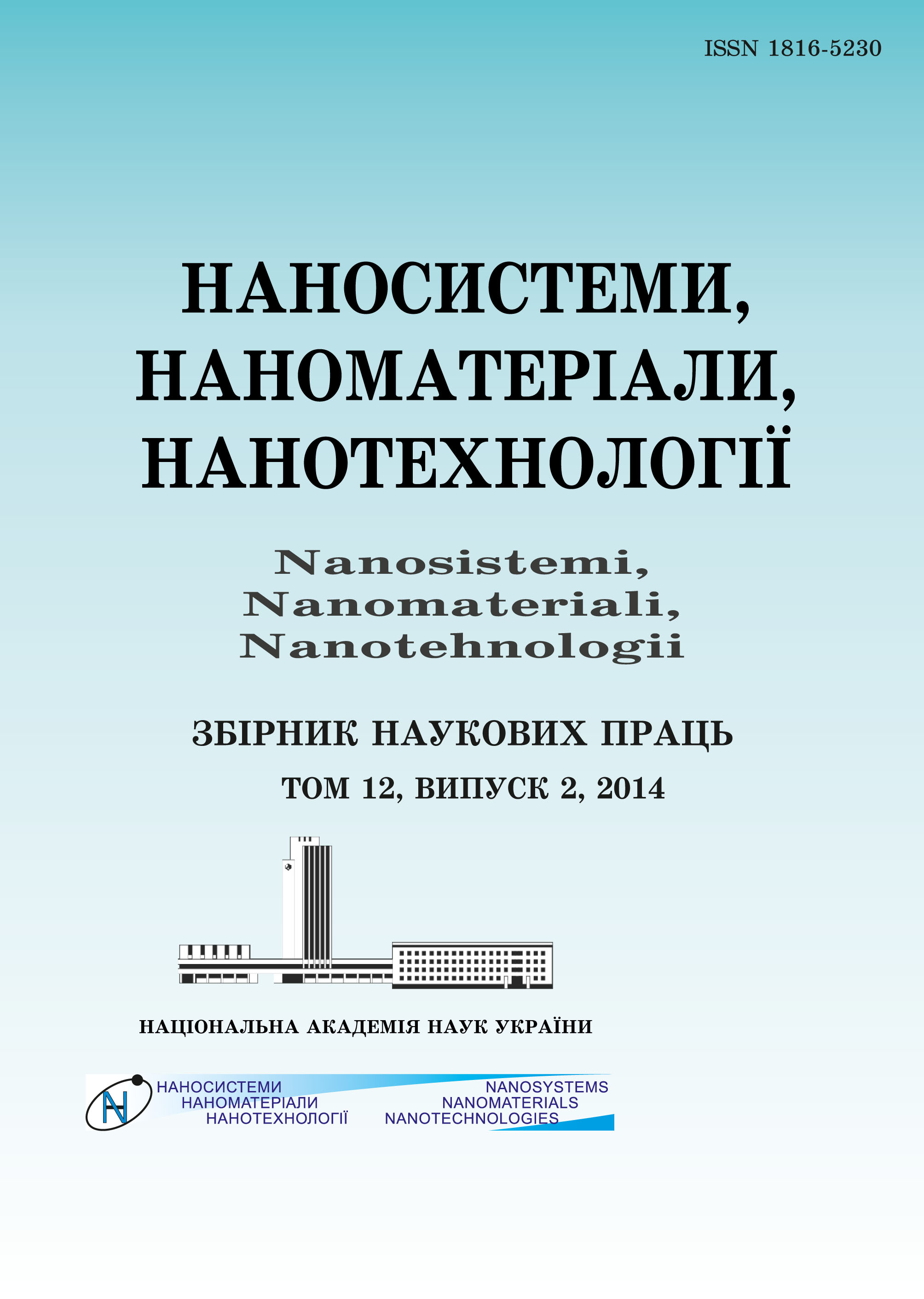|
|
|||||||||

|
Year 2024 Volume 22, Issue 2 |
|
|||||||
|
|||||||||
Issues/2024/vol. 22 /issue 2 |
|
M.A. ZABOLOTNYI, L.I. ASLAMOVA, H.I. DOVBESHKO, O.P. HNATIUK,
H.I. SOLIANYK, V.P. DANKEVYCH, D.S. LEONOV, M.Yu. BARABASH, and
V.A. CHERNIAK
The Effect of High-Energy Electron Irradiation of
Saline Solution on Its Optical Characteristics and Cytotoxic/Cytodynamic Activity
481–499 (2024)
PACS numbers: 33.20.Kf, 33.20.Lg, 42.50.Gy, 78.40.Me, 87.19.xj, 87.53.-j, 87.64.kv
The work investigates the processes determining the characteristics of the method of increasing the effectiveness of the antitumor effect of doxorubicin without the use of extraneous nanoimpurities. The method is based on the use of high-energy electron irradiation of physiological saline (PS) before dissolving doxorubicin in it. The energy of the irradiation electrons is equal to 1 MeV, and the absorbed dose (gray) is in the range of 4–80 kGy. Doxorubicin (Sigma, USA) is used in the study, and the Lewis lung carcinoma cell line (LLC) given by the R. E. Kavetsky Institute of Experimental Pathology, Oncology and Radiobiology (IEPOR), National Academy of Sciences of Ukraine is used to determine the pharmacological characteristics of doxorubicin. It is proven that the amount of the absorbed dose affects the optical absorption and fluorescence spectra of the samples and leads to an increase in the cytotoxic/cytostatic effect of the drug, which is most pronounced at relatively low concentrations. The number of live LLC cells under the influence of doxorubicin in the irradiated solvent at concentrations less than 3 µM is decreased to 15% compared to the corresponding indicator under the action of doxorubicin without irradiation of the solvent. A comparative study of the acute toxicity of irradiated PS is carried out. The results of the study do not provide convincing data that would indicate differences in the toxicity profiles of irradiated and non-irradiated PSs
KEY WORDS: physiological salt solution, doxorubicin, bubstones, electron irradiation, cytotoxicity, fluorescence, extinction
DOI: https://doi.org/10.15407/nnn.22.02.481
REFERENCES
- Mateusz Kciuk, Adrianna Gieleci?ska, Somdutt Mujwar, Damian Ko?at, ?aneta Ka?uzi?ska-Ko?at, Ismail Celik, and Renata Kontek, Cells, 12, No. 4: 659 (2023); doi:10.3390/cells12040659PMCID:PMC9954613PMID:36831326
- Saad N. Mohammad, Yeon Su Choi, Jee Young Chung, Edward Cedrone, Barry W. Neun, Marina A. Dobrovolskaia, Xiaojing Yang, Wei Guo, Yap Ching Chew, Juwan Kim, Seunggul Baek, Ik Soo Kim, David A. Fruman, and Young Jik Kwon, Journal of Controlled Release, 354: 91 (2022); https://doi.org/10.1016/j.jconrel.2022.12.048
- Da-Yong Lu, Ting-Ren Lu, Bin Xu, Jin-Yu Che, Ying Shen, Nagendra Sastry Yarla, Current Pharmacogenomics and Personalized Medicine, 16, No. 2: 156; DOI: 10.2174/1875692116666180821095434
- Peter Keating, Alberto Cambrosio, Nicole C. Nelson, Andrei Mogoutov, and Jean-Philippe Cointet, Front. Pharmacol., 4: 58 (2013); https://doi.org/10.3389/fphar.2013.00058
- M. A. Zabolotnyy, M. P. Kulish, O. P. Dmytrenko, G. I. Solyanyk, Yu. I. Prylutskyi, M. A. Drapikovskyi, M. O. Kuzmenko, N. A. Poluyan, and V. A. Kiyashko, Method of Modification of Water-Soluble Antitumor Drugs by Means of Radiation Irradiation (Patent for invention (UA) No. 116 227; Registered on February 26, 2018).
- L. Aslamova, M. Zabolotnyy, G. Dovbeshko, G. Solyanik, O. Gnatyuk, and M. Tsapko, Proceedings of International Conference ‘Medical Physics 2023’ (9–11 November, 2023, Kaunas, Lithuania).
- M. A. Zabolotnyy, L. I. Aslamova, G. I. Dovbeshko, O. P. Gnatyuk, V. B. Neimash, V. Yu. Povarchuk, V. E. Orel, D. L. Kolesnyk, L. M. Kirkilevska, and G. I. Solyanyk, Nuclear Physics and Atomic Energy, 23, No. 2: 131 (2022).
- Joseph M. Grogan, Nicholas M. Schneider, Frances M. Ross, and Haim H. Bau, Nano Lett., 14, No. 1: 359 (2014); https://doi.org/10.1021/nl404169a
- W. Hergert and T. Wriedt, The Mie Theory (Berlin: Springer-Verlag: 2012); doi:10.1007/978-3-642-28738-1
- Î. Ì. Êàðàìàí, Í. ². Ôåäîñîâà, ². Ì. Âîºéêîâà, Ã. Â. ijäåíêî, Â. Â. Ñàðíàöüêà, Ë. Î. Þøêî, Î. Ì. Ïÿñêîâñüêà, Ã. Ï. Ïîòåáíÿ, Â. Ã. ͳêîëàºâ, Ã. ². Ñîëÿíèê, Îíêîëîã³ÿ, 18, ¹4: 262 (2016); O. M. Karaman, N. I. Fedosova, I. M. Voieikova, H. V. Didenko, V. V. Sarnatska, L. O. Yushko, O. M. Piaskovska, H. P. Potebnia, V. H. Nikolaiev, and H. I. Solianyk, Onkolohiia [Oncology], 18, No. 4: 262 (2016) (in Ukranian).
- Joseph M. Grogan, Nicholas M. Schneider, Frances M. Ross, and Haim H. Bau, Nano Lett., 14, No. 1: 359 (2014); https://doi.org/10.1021/nl404169a
- Anastasios W. Foudas, Ramonna I. Kosheleva, Evangelos P. Favvas, Margaritis Kostoglou, Athanasios C. Mitropoulos, and George Z. Kyzas, Chemical Engineering Research and Design, 189: 64 (2023); https://doi.org/10.1016/j.cherd.2022.11.013
- F. Fogalari, A. Brigo, and H. Molinari, J. Mol. Recognit, 15: 377 (2002); https://doi.org/10.1002/jmr.577
- Minmin Zhang, R. James, and T. Seddon, Langmuir, 32, No. 43: 11280 (2016); https://doi.org/10.1021/acs.langmuir.6b02419
- Ya. Goroshchenko, A. V. Nesterov, and V. A. Nesterov, Nuclear Physics and Atomic Energy, 21: 013 (2020); https://doi.org/10.15407/jnpae2020.01.013
- J. M. Tenti, S. N. Hern?ndez Guiance, and I. M. Irurzun, Physical Review E, 103: 012138 (2021); https://doi.org/10.1103/PhysRevE.103.012138
 This article is licensed under the Creative Commons Attribution-NoDerivatives 4.0 International License ©2003—2024 NANOSISTEMI, NANOMATERIALI, NANOTEHNOLOGII G. V. Kurdyumov Institute for Metal Physics of the National Academy of Sciences of Ukraine. E-mail: tatar@imp.kiev.ua Phones and address of the editorial office About the collection User agreement |